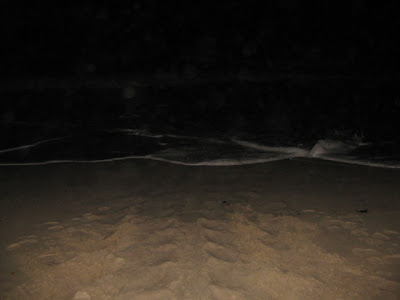We've been coming here to Trinidad for haulout since 2005 and haven't done much in the line of tours until last night. We have been hearing so much about the trip to see the Leatherback turtles laying eggs on the beaches of Trinidad and decided that it was time to join in. The event only happens from April to June, so this would be the perfect time. The fee included a 2 hour drive to the east coast and a meal along the way. Of course, Jesse teased us with trivia tests and gave us much information along the way. When we arrived at the beach, we were to meet the guides and volunteers who protect the turtles during this time. The hatchlings will come out in July and August and only a few will survive after the birds and sea creatures get their share.
We arrived at the site at around 9:00 pm and were told by the park rangers/guides/volunteers, that there was a turtle on the beach who had arrived there about 15 minutes ago and was already digging a hole for her eggs. Jesse James, our tour guide from the Chaguaramas Bay area had given us quite a few tips before we were to arrive at the beach. We were NOT to take pictures with flashes at any time other than when the turtle was actually depositing eggs into the hole. We would then be able to touch her because she would be in a trance-like state. All flashlights were to be turned off at this point and we could watch by moonlight. The whole episode would take approximately an hour and a half at which time the turtle would be exhausted and head back to the ocean through the surf.

The guides found that this turtle had not been tagged, so while she was busy, they went to work and gave her a bit of turtle 'bling'. They'll collect information to learn more about how to protect this species.

She shed a few tears while she was out of the water for the hour and a half just to keep her eyes moist.

We are told that once the female begins to deposit the eggs, she is in a trance-like state and is not bothered by touching, or photo flashes.

The red that you see in front of Laurie is a red light from a flashlight. It's a little less noticeable to the turtle.

The back of the turtle lived up to its name, it felt soft, plyable and very leathery.

After her eggs were deposited, she spent about 20 minutes covering them up with her large flippers. You could see her muscles working hard to tamp down the sand. When the hole was completely filled in and tamped, she took her flippers and flicked sand everywhere. We really had to move back because the sand flew for about 12 feet in all directions. She eventually worked her way to other areas so that a very large area was affected and the actual small hole she had made was unrecognizable as a turtle nest.
She was gone and we were able to take pictures again. The tracks remind one of tractor tread prints on the beach.

We watched her slowly making her way back to the ocean. This is the last time she'll deal with these eggs, they're entirely on their own from here on.

While we were there, 2 other females made their way up the beach, but it was time for us to go. One of the guides told me that during peak season, there can be over 60 leatherbacks on the beach at one time.
Diving deep and fast is their only protection from predators, namely sharks and killer whales. In fact, some of these turtles arrive without hind flippers and still go about their business. In these instances, the local volunteers dig the holes and help fill and tamp down the sand. We assume the turtle thinks she is doing it!
Here are some additional facts I found on the Internet today:
The leatherback is the largest, deepest diving, and most migratory and wide ranging of all sea turtles. The adult leatherback can reach 4 to 8 feet in length and 500 to 2000 pounds in weight. Its shell is soft and unlike many other turtles, it can’t retract into it. Jellyfish are the main staple of its diet, but it is also known to feed on sea urchins, squid, crustaceans, tunicates, fish, blue-green algae, and floating seaweed.
Adult females require sandy nesting beaches backed with vegetation and sloped sufficiently so the crawl to dry sand is not too far. The preferred beaches have proximity to deep water and generally rough seas.
Nesting occurs from about March to July. Female leatherbacks nest 5 to 7 times within a nesting season or about every 9 to 10 days. The nests are constructed at night in clutches of about 70 to 80 yolked eggs. Typically incubation takes from 55 to 75 days, and emergence of the hatchlings occurs at night. Most leatherbacks remigrate to their nesting beaches at 2 to 3-year intervals.
